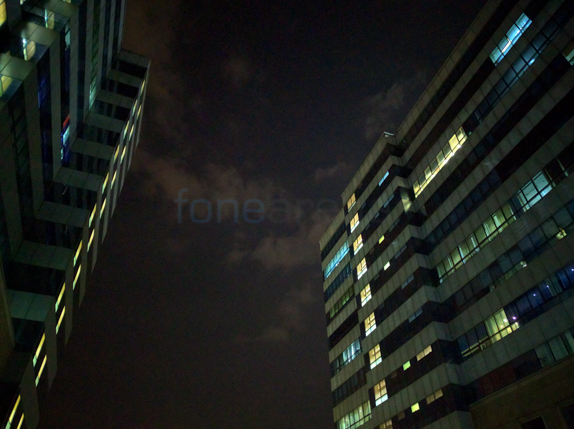
Unlike their usual style of launching a single smartphone per year, this year Google decided to launch two Nexus smartphones. The 6P is the flagship smartphone of the two. The 5X which we reviewed earlier proved to be a phone with good value for money. Despite previous Nexus phones trying their best to replace or provide alternatives to flagships, they have always failed and given a sub-par experience in some categories. The Motorola Nexus 6 was probably one of the boldest moves in the Nexus lineup and while it did tick many of the right boxes, it too fell short on becoming a suitable alternative to many products. Many people simply got it for the stock Android experience. With the 6P however, it seems that there are several things to make you want to buy the phone other than the stock Android experience alone. How does it perform in real life though? Let us take a look in the detailed review.
Unboxing
We have already unboxing the Google Nexus 6P and here is the video:
httpv://www.youtube.com/watch?v=Ez6K1OwD2KI
The contents of the box are:
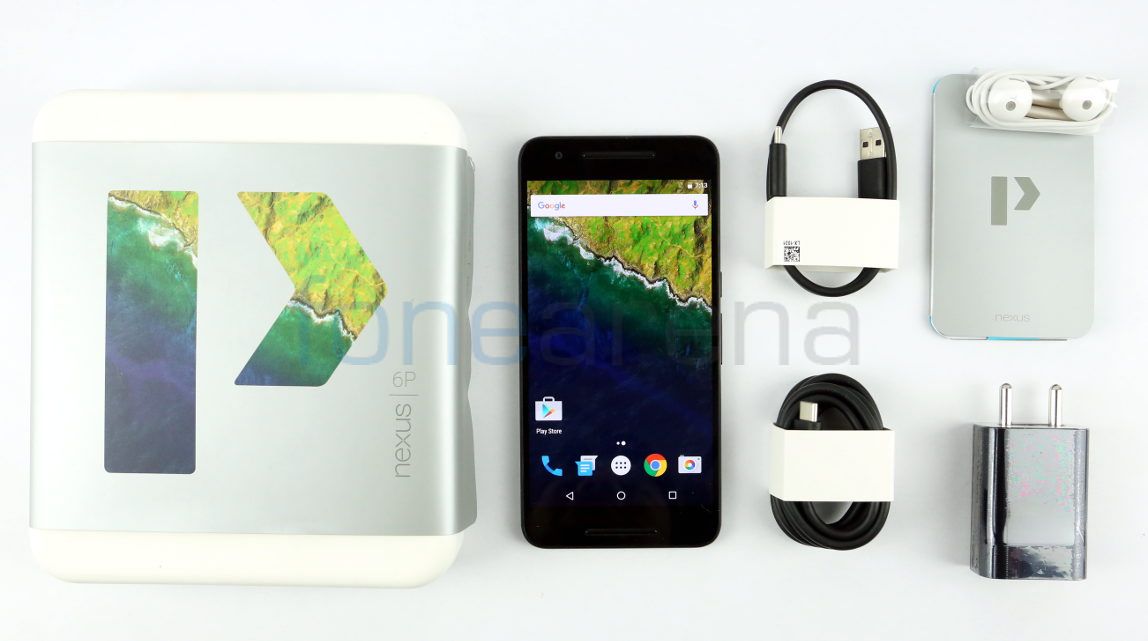
- Huawei Nexus 6P smartphone in Graphite / Grey color (32GB)
- Headset with microphone
- USB Type-C 15W (5V-3A) charger
- 1.2 m USB Type-C to Type-C cable
- 0.3 m USB Type-A to Type-C cable
- SIM ejector tool
- Quick start guide, Safety and Warranty information
Video Review
httpv://www.youtube.com/watch?v=6MO1lz4YzBA
Design, Materials and Build Quality
Up front, the Google Nexus 5X and the Nexus 6P look nearly identical. In fact, the 6P itself is not much of a departure from the Nexus 6 design but what changes is the aspect ratio. The Nexus 6 has a wider design that was tough to handle and the 6 inch screen only made matters worse. The 6P on the other hand has a smaller 5.7″ display but is taller than the Nexus 6. As a result, the 6P is much easier to handle and use. While it isn’t the smallest phablet out there and not even the smallest 5.7″ handset in the market, the handset feels easy enough to handle for a device of its size. It is heavy at 178 grams but the weight is well-distributed over the surface area so it doesn’t affect your use practically. Also, the phone has a slim waistline at 7.3mm despite having a larger footprint. The curved edges at the back also make it easier to grip.
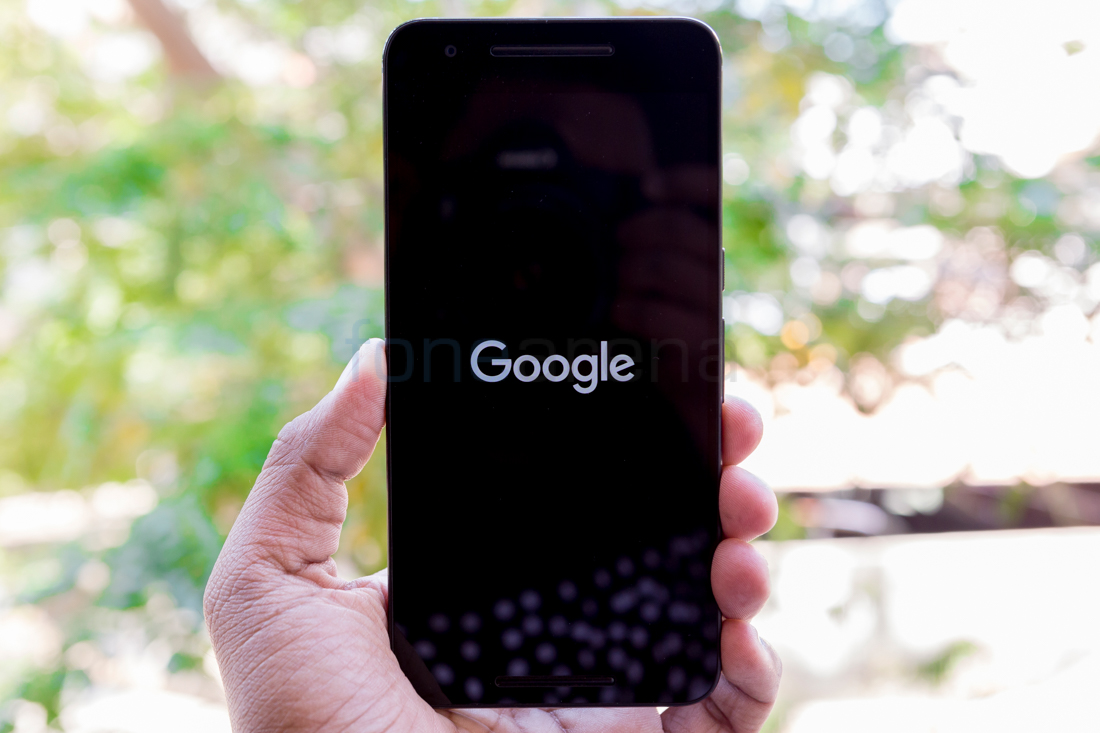
The build quality is solid and even more surprising considering that it was made by Huawei, a Chinese manufacturer. I would go as far as to say that it is the best built and designed Nexus smartphone ever. Metal and glass have been seamlessly integrated to give a nice premium feel that gives the impression that it costs more than it does. The matte finish at the back provides good grip and does a good job at keeping most fingerprints at bay.

The front is dominated by the 5.7″ display and while the bezels are still big on top and bottom, they have done good to reduce the bezels on the sides at least. There are stereo speakers both above and below the display as well as the usual set of proximity and ambient light sensors plus the front facing camera above the display. The speaker at the top also doubles as the earpiece.

On the right side, we have the power button and the volume rocker button. These too are made of metal and are sufficiently raised from the body offering good feedback. The positioning too is spot on and the controls are easy to reach. The awkward positioning of the keys on the 5X isn’t an issue that is replicated here.

At the left, there is only a slot for the SIM tray. The SIM tray itself is a single-SIM tray but has the size and shape of a dual-SIM tray with the second slot being blocked out by a metal strip. We wonder whether Huawei had developed it as a dual SIM device but decided to go with the single-SIM variant finally.

The top houses the 3.5mm audio jack while you find the USB Type-C port at the bottom. The first thing you notice at the back is the camera module. The entire camera unit along with the dual-tone LED flash and laser AF are housed within a glass frame that is raised from the rest of the body. Most images that are available online suggest that this hump is quite prominent and might affect the handling of the device.

However, in real life, the bump is smaller than it looks on photos and the inclination is gentle. It most definitely does rest on a surface so be careful when sliding it across a surface or so. Huawei claims that the glass is quite scratch resistant and while we didn’t get our unit scratched so far, we would rather be safer and protect that area. Below the camera unit is the secondary microphone.

Below that is the fingerprint sensor which is depressed into the body and then you have a Nexus branding as well. The bottom portion features a plastic cutout to facilitate better cellular and wireless reception. The same has been achieved at the top using the glass for the camera unit.

Overall, it is a very elegant design that we quite admire. It handles well, feels good and oozes premium. The 6P is available in a Graphite, Silver and Gold variants. The Gold is rarer to find and is available only in a select few regions. All three colours have their own appeal but we personally prefer the Graphite one. Gold might attract a few users too but it doesn’t really suit the 6P in my opinion.
Display
The display unit on the Nexus 6P isn’t a 6 incher like its name might suggest. Although the Nexus 6 had a 6 inch display, the 6P actually houses a 5.7″ AMOLED panel with 1440p resolution. The display offers really good brightness, contrast and sharpness. The sunlight legibility too is quite good owing to the less reflective glass and high contrast levels. The display isn’t as bright as Samsung’s Galaxy Note5 even though the 6P uses a Samsung sourced display but it still is good enough for any environment.

The lowest brightness levels also make it comfortable to read when you are in complete darkness. The colours too are pretty good but are a bit more saturated than normal. You can view the screen clearly even at really ridiculous angles and thus makes content consumption much easier. The notification light is located at the top unlike the 5X which had it housed within the speaker below the display. It is capable of displaying different colours and is bright enough to easily notify you of stuff you missed. The display is near perfect and the only thing we felt was missing was a proper 2.5D effect that would’ve made swiping and using the screen more enjoyable. The glass for protection is Corning Gorilla Glass 4 which does a good job at keeping the device protected from scratches.


Adaptive brightness does a good job at regulating the screen brightness to desirable levels based on the surrounding light. Users can also turn on ambient display which is a feature similar to Moto Display. It basically wakes your phone screen when you pick up the device or receive a notification. A quick way to access the camera is by double pressing the power button twice. It will take you directly to the camera interface regardless of whether you phone is awake or asleep. You can also setup this to launch 3rd party camera apps if needed.
Fingerprint Sensor

Like the fingerprint sensor on the Nexus 5X, the 6P too has a blazing fast fingerprint sensor. It is as fast if not faster than the 5X. But it is more comfortable to use and position your finger as well since the dimple is deeper. It also is more accurate and works even if your fingertips or the sensor is a bit wet. If it’s really wet then it too will fail to recognise it, but it does a better job than the 5X.

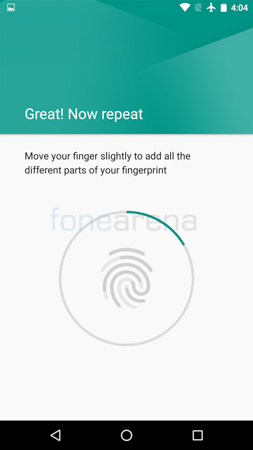
The fingerprint feature is known as a Nexus Imprint. The process of registering a finger too is one of the fastest on any phone as it take just 6 taps. You just place your finger on the sensor, lift when the phone vibrates and repeat. All the user has to do is place their finger on the sensor and it will unlock the device without you even having to wake it up. You could also wake up the device first by pressing the power button and then placing your finger on the sensor. Registering fingerprints too is really fast and you can register several at a time. The orientation of your finger doesn’t really matter either as it can even detect your finger when it is upside down. Since the phone runs on Marshmallow, the fingerprint can be used to make payments on Android Pay or Google Play Store apart from just unlocking the device. Users can also set up a backup PIN, password or pattern to access the device in case the fingerprint authentication method fails.
Calling and Messaging

Call quality is very good on the Nexus 6P both over the earpiece as well as the loudspeaker. Loudness too is more than sufficient in both cases. The secondary noise cancelling mic also does a good job at relaying your voice to the other end without any issues. The dial-pad is large and easy to use even for people with large fingers.


The default keyboard on the device is the Google Keyboard. We quite like the layout and the large screen made typing an enjoyable experience. You can choose to install a 3rd party keyboard at any point of time if you prefer to do so.
Software and UI

This is probably the most important aspect of any Nexus smartphone. The 6P is no different as it runs on the latest version of Google Android which is Marshmallow. At the time of writing this review, the latest version on the phone is Android 6.0.1 Marshmallow and comes with the latest security patch dated 1st December 2015. Google has promised to issues monthly updates in order to fix any flaws in security. It should also bring about changes and improvements to performance.


The UI is just as you would find on any other stock Android. There is an app drawer that displays the apps that you can scroll through vertically. The notification drawer can be accessed by pulling down the bar at the top. You can remove individual notifications or all at once. Pulling it down further will give you quick toggles and shortcuts as well as a brightness control slider. You can also choose the user or guest from here.


Being Marshmallow, you can see many of the new features and changes from Lollipop. First thing you would notice immediately is the permissions. Starting off, the phone asks for permissions for multiple things. Installing, giving an app access to a camera or the internet etc. You can choose to deny all permissions or a particular permission for an app. You can now reset just your network settings without having to reset the entire device itself. The new Doze feature allows the phone to go into a deeper state of sleep than previously capable. We shall talk more about this in the battery section later on. The lockscreen gives you quick shortcuts to the dialer as well as the camera. You also get information regarding the day, date and time. Users can choose whether to show all notifications, hide sensitive content or show no notifications at all.


Storage, Connectivity and Performance
The Google Nexus 6P features a single-SIM sot that is 4G LTE capable. It takes a single nano-SIM and supports both Band 3 (1800MHz) and Band 40 (2300MHz) LTE bands in India as well. Like we mentioned earlier, the SIM tray on the 6P suggests that Huawei and Google were developing a dual-SIM Nexus 6P or at least a dual-SIM variant to go alongside the single-SIM one. It would’ve definitely been a good thing to have for some users.


As with most Nexus devices, the 6P too lacks a microSD card slot but it makes up for it in terms of storage variants. The 6P comes in 32, 64 and 128GB capacities although the 128GB version is not available everywhere. The 32GB variant comes with 25.01GB while the 64GB variant comes with 53.67GB of space out of the box.
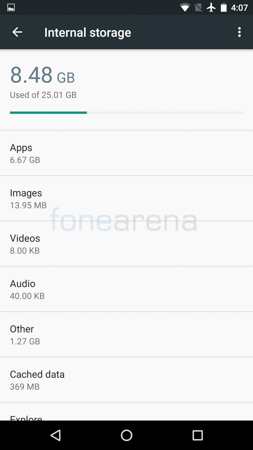

The Nexus 6P has a USB Type-C port that take a reversible connector. No more hassles trying to find the right way up or down. Huawei luckily provides both a Type-C to Type-C as well as a Type-A to Type-C cable in the box. LG on the other hand provided just a Type-C to Type-C cable with the 5X. Thus, owners of the 6P won’t have any issues transferring content from their PC to the smartphone. The 6P also has dual-band WiFi 802.11 a/b/g/n/ac and Bluetooth 4.2. The Type-C port can also be used to charge other devices and also as a MIDI input.


The 6P is powered by v2.1 of the Octa-Core Snapdragon 810 chipset. The only spec where it may seem inferior to some of the latest flagship products is that it has 3GB of RAM. While the 6P doesn’t hang up or lag in any way, there are some handsets out there that provide 4GB of RAM. So that may upset some people but don’t fret since the performance is pretty good. Out of 3GB of RAM, the phone has a total of 2.6GB of memory and the phone uses around 1.5GB of memory when just the default apps are running in the background. You can check a few of our benchmark scores below. For the full-fledged benchmark results, check this post.


Music Player and Audio Quality

The default music player on the 5X is Google Play Music. It shows you content that is stored both locally as well as online. Users can sort tracks in terms of track title, album, artists, playlist and folders. You have the vote up or down controls as well as the usual playback controls in the now playing screen with the album art. There is an equalizer as well with different presets or you can define your own. There is a surround effect that works with both headphones and speaker and a bass boost feature that works with just earphones.


The 6P has good audio quality over the earphones and has good loudness as well. The dynamic range is pretty good as well and the stereo crosstalk is minimal. What really surprised us are the speakers. The 6P comes with a really good set of speakers that are both loud as well as clear. It is good enough to be your music source at a party for example and is miles ahead of its Nexus partner, the 5X both in terms of loudness as well as clarity. The positioning of the speakers are good too since it doesn’t get muffled or so if you place it flat on a surface.
Camera

The camera on the Nexus 6P is identical to the one featured on the Nexus 5X in terms of hardware specifications. However, there is still a slight difference in terms of the image quality and the cameras capabilities. Whatever the Nexus 5X can do, the Nexus 6P can do better. Be it low light capture, shutter speeds or focusing speeds. This is mainly due to the 6P having a more powerful processor. The camera is a 12.3 Megapixel unit with an aperture of f2.0 aperture and a dual-tone LED flash. There is a laser AF as well that helps to lock focus on objects faster.
In terms of image quality the phone does really well. Images are bright, well detailed and have good colour. White balance too is spot on and the Laser AF is quite fast to lock onto a subject. However, we have seen phones with faster AF even without laser assist. Sometimes the AF does hunt a bit especially on tiny objects or subjects in the frame. The camera has a maximum aperture of f2.0 which can take images with really good bokeh when focused up close. The dynamic range is pretty good too but sometimes the highlights are blown out of proportion. This can be solved using the HDR+ mode. But even in the said mode, the phone can take very different photos and in our experience what worked best is to meter on the shadows. That is because the phone recovers enough details from the shadows and makes sure that the highlights aren’t blown out.
Click on any of the photos below to get the full resolution samples.
The images on the left are shot in normal mode while the ones on the right are shot in HDR+ mode.
Low-light shots do a good job at keeping the noise in check. As the light reduces, there is a gradual increase in the noise levels but nothing alarming and is one of the best we have seen perform in low-light. The phone also has a dual-tone LED flash that is really powerful. Thanks to the dual-tone it captures skin tone much better as opposed to a single tone flash colour. The flash also doubles up as a really capable flashlight. The shutter speed is fast enough in most conditions to eliminate shakes but the lack of OIS definitely affects videos.
Videos shot on the Nexus 6P are really detailed and have good colour as well but unfortunately there is no OIS to keep the video stable. As a result every movement looks too sudden and jaggered, sort of like a jelly or jello effect which is a shame as we can only imagine how good the videos would’ve looked with OIS as well. There is a built-in software stabiliser which is something that the Nexus 5X didn’t have but that isn’t good enough to offer a really stable video. Sony and Moto have mastered the art of software stabilisation for videos and we feel that Google can learn a thing or two from them.. We at least wish they had some sort of software stabilization even if it did narrow the field of view. The Nexus 6P can record videos at a maximum resolution of 4K at 30 fps. Check out the 4K and 720p slow motion video samples below.
httpv://www.youtube.com/watch?v=DLvWWz9ciPY
httpv://www.youtube.com/watch?v=_yA1r2c75zQ
The front camera is different from the one on the 5X however. On the 6P, you get an 8 Megapixel f2.4 unit that is also capable of recording 1080p videos at 30 fps. The image quality is pretty decent for a front facing camera as it produces bright images and takes them quite fast. The detailing isn’t great though but should be good enough to share on social media. Additionally the 6P can also capture slow motion videos at 240 frames per second at 720p resolution.


The camera software is pretty easy to use. When held in portrait mode, you have the camera switch key at the bottom left, the shutter button at bottom centre and gallery shortcut at bottom right. There is a mode switch above the shutter button that toggles between photo and video modes. At the top left, you have the settings and at the top right, you have the controls for timer, HDR modes and flash. In photo mode, users can choose between regular photos, photo sphere, panorama and lens blur. Video mode allows you to choose between regular 30 fps videos or 120 fps slow motion videos. Users can capture 4:3 aspect ratio images at a maximum resolution of 12.2 megapixels and 16:9 aspect ratio images at 8.3 megapixel resolution. The photo sphere mode works really well and the stitching is one of the best we’ve seen on a smartphone. Users can also specify the quality of their panorama photos.
Battery Life

The battery on the Nexus 6P is a 3450 mAH one that is non-removable. The Nexus 6P scored a one charge rating of 13 hours and 18 minutes in our battery tests. For the full fledged results, check out our detailed battery test post. The battery on the 6P is probably the best on any Nexus device so far. It does a real good job at keeping the battery consumption to a minimum especially when the device is on standby. However, when in use, the phone doesn’t perform as well as say the Note5 and as a result falls just short. We hope that Google will continue to optimise battery consumption in the future and make the device even better.
When the 6P runs out of juice, the battery can be recharged quite quickly as the device supports quick charging. However, you will have to use the charger that is bundled with the phone as it has a maximum output rating of 3A. The charger has a USB Type-C port and you’ll have to use the Type-C to Type-C port. The 6P can also be used to charge another device using the dual ended Type-C port which is a feature of Marshmallow.
Conclusion

Like with most smartphones that Google releases every year, I had my reservations about the Nexus 6P too. But I am glad to say that it exceeded my expectations in almost every aspect. It is a near perfect smartphone which is great not just by Nexus standards but also a smartphone that can put up a fight and knock out a few flagships from other brands too. What is more surprising is that after big brands such as HTC, LG and Samsung, the feat was achieved by Huawei on their first attempt at making a Nexus phone. If you want a high-end flagship smartphone with all the bells and whistles and want/don’t mind the stock Android experience, then you are going to love this phone. It also makes me hopeful about the next generation of Nexus smartphones from Google and I hope that they give Huawei another chance to make a Nexus phone. The Nexus 6P costs Rs. 39,999 for the 32GB version and Rs. 42,999 for the 64GB version. The Nexus 6P reminds me of the Dark Side (Star Wars reference) and like the Dark Side, it does come with a lot of power and once you experience it, you will be tempted to get one for yourself.
Pros
- Great Design and Build Quality
- Brilliant Loudspeaker
- Great Camera Quality
- Good Screen
- One of the Fastest Fingerprint Sensors on Any Phone
- Easy to Handle Despite the Large Size
- USB Type-C Port
Cons
- No OIS (Jelly-like Video Effect Due to Lack of It)
Siraj, Srivatsan and Dhruv contributed to this post











